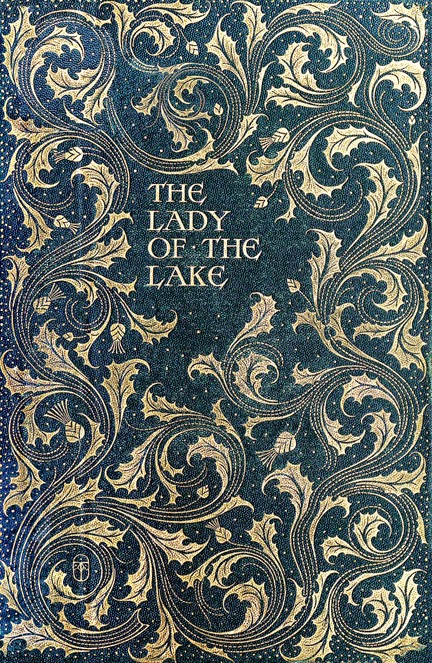Block 31: Lady of the Lake for Sir Walter Scott by
Bettina Havig
Walter Scott (1771 -1832)
Walter Scott was a literary lion, as celebrities were known in Jane Austen’s England. Scott was first lionized for his poetry chronicling a romantic Scottish past. Jane’s brother James read Scott’s poem Marmion aloud to the family in the evenings. Wrote Jane: “Ought I to be very much pleased with Marmion?-as yet I am not.”
The Lady of the Lake illustrated by
Charles E. Brock, 1904

Etching by Cruickshank
Scott's 1810 poem, The Lady of the Lake, sold 25,000 copies making him rich.The following year Sense & Sensibility, Jane’s first published novel, appeared. The Austens (probably Henry and Eliza) put up money for printing and publicity. With sales of 750 copies, Jane earned £140 over that investment.
An American silk picture embroidered about
1810. Scott's historical fiction particularly touched Southerners
and other Americans with Scots-Irish roots.
Scott then turned to prose fiction with Waverly and Jane commented to niece Anna, “Walter Scott has no business to write novels, especially good ones. -- It is not fair. He has Fame and Profit enough as a Poet, and should not be taking the bread out of other people's mouths.-- I do not like him, and do not mean to like Waverley if I can help it -- but fear I must.”
The Quarterly Review was published by John Murray,
the prestigious house that published Scott, Byron and Jane Austen’s Emma.
Five years later Scott criticized Jane in a public book review. Discussing Emma for The Quarterly Review, he was positive but not overly enthusiastic.
Was this faint praise? A decade later he was more enthusiastic to his journal:
“The author is already known to the public by the two novels [which] belong to a class of fictions which has arisen almost in our own times, and which draws the characters and incidents introduced more immediately from the current of ordinary life than was permitted by the former rules of the novel.”Scott distinguished between the former rules, which presented “splendid scenes of an imaginary world” and Jane Austen’s new genre, giving “a correct and striking representation of that which is daily taking place….
"We, therefore, bestow no mean compliment upon the author of Emma, when we say that, keeping close to common incidents, and to such characters as occupy the ordinary walks of life, she has produced sketches of such spirit and originality, that we never miss the excitation which depends upon a narrative of uncommon events.”
Lady of the Lake by Becky Brown
Was this faint praise? A decade later he was more enthusiastic to his journal:
“Read again, and for the third time at least, Miss Austen’s very finely written novel of ‘Pride and Prejudice.’ That young lady has a talent for describing the involvements and feelings and characters of ordinary life which is to me the most wonderful I ever met with. The big bow-wow strain I can do myself like any now going; but the exquisite touch, which renders ordinary commonplace things and characters interesting, from the truth of the description and the sentiment, is denied to me.”
It seems he was as envious of Jane’s skills as she was of his financial success.
Captain Benwick by Charles Brock from Persuasion,
in which Anne Elliot and the Captain discuss romantic poets
Scott and Byron.
Lady of the Lake by Becky Brown
BlockBase #2183 and K020
Lady of the Lake, named for Scott’s “big bow-wow strain” of a poem, is perfect to recall Jane Austen’s fan and fellow novelist. The name was given a similar pattern by the Ladies’ Art Company about 1900, inspired, perhaps, by the poem's upcoming centennial. The pattern is a modified version of BlockBase #2183 (similar to #K020).
Cutting a 12” Block
A - Cut 20 squares 2-7/8” (5 each of 4 shades). Cut each in half with a diagonal cut to make 2 triangles.
B - Cut 2 squares (1 light, 1 dark.) 8-7/8”. Cut each in half with a diagonal cut to make 2 triangles.
You need 2 large triangles, 1 light, 1 dark.
You need 2 large triangles, 1 light, 1 dark.
Sewing:

A sewing kit celebrating Walter Scott's works with tartan-covered tools and miniature versions of two books.
See more of Scott and Austen here at Jane Austen in Vermont:
http://janeausteninvermont.wordpress.com/2009/03/13/sir-walter-scott-on-austen-march-14-1826/
Read Scott’s lengthy review here:
http://onlyanovel.wordpress.com/austen-reviews/sir-walter-scotts-review-of-emma/
See more of Scott and Austen here at Jane Austen in Vermont:
http://janeausteninvermont.wordpress.com/2009/03/13/sir-walter-scott-on-austen-march-14-1826/
Read Scott’s lengthy review here:
http://onlyanovel.wordpress.com/austen-reviews/sir-walter-scotts-review-of-emma/
King George IV by David Wilkie, 1829
A fanciful portrait of the King in a fanciful tartan costume.
Scott inspired a fad for plaid.
Read more about Jane's income for her best-selling books here:
http://thebillfold.com/2014/04/how-much-was-jane-austen-paid-for-some-of-historys-best-books/#more-50495





















Love the tartan sewing set, where is it currently? Thank you for sharing.
ReplyDeleteDawn Saw it at an online auction I think.
ReplyDeleteGreat blog I enjoyedd reading
ReplyDeleteNow I now where the name mccalla come from king George
ReplyDelete